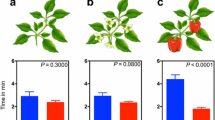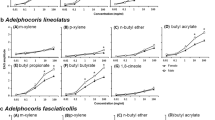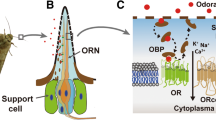Absract
Insect herbivores use olfactory and visual cues during host plant finding. Although insect responses to these cues typically are assessed separately, in nature herbivores respond to olfactory and visual cues simultaneously. We demonstrate the functionality of a “double-stacked y-tube device” (D-SYD) to measure bioassay responses of a specialist herbivore to olfactory and visual cues of potential host plants either presented individually or in combination. We tested the ability of the Eurasian specialist seed-feeding weevil, Mogulones borraginis, to distinguish between its Eurasian host, Cynoglossum officinale, which is invasive in North America, and a closely related confamilial native North American non-target, Andersonglossum occidentale. Weevils distinguished C. officinale from A. occidentale based on olfactory and visual cues. When olfactory and visual cues were offered simultaneously, weevils preferentially selected C. officinale more strongly and more rapidly than when either single cue was offered. When olfactory and visual cues were mismatched, weevils were no longer able to discriminate between the plant species and exhibited longer response times. There were no differences in behavioral responses to floral scents from greenhouse-propagated plants and those collected from plants in the field using a portable volatile collection system (PVCS). The bioassay approach demonstrated here using D-SYD and PVCS can assess behavioral responses of insects to olfactory and visual plant cues alone or together and measure their relative contributions to host discrimination. This will have utility for theoretical and applied questions concerning the host selection behavior of insect herbivores.




Similar content being viewed by others
References
Andreas JE, Schwarzländer M, Ding H, Eigenbrode SD (2009) Post-release non-target monitoring of Mogulones cruciger, a biological control agent released to control Cynoglossum officinale in Canada. In: Proceeding of the 12th International Symposium on Biological Control of Weeds, La Grande
Balkenius A, Bisch-Knaden S, Hansson B (2009) Interaction of visual and odour cues in the mushroom body of the hawkmoth Manduca sexta. J Exp Biol 212:535–541
Bernays EA, Chapman RF (1994) Host plant selection by phytophagous insects. Chapman and Hall, New York
Bruce TJ, Pickett JA (2011) Perception of plant volatile blends by herbivorous insects-finding the right mix. Phytochem 72:1605–1611
Burger H, Dotterl S, Ayasse M (2010) Host-plant finding and recognition by visual and olfactory floral cues in an oligolectic bee. Funct Ecol 24:1234–1240
Chacón J et al (2016) The borage family (Boraginaceae s. str.): a revised infrafamilial classification based on new phylogenetic evidence, with emphasis on the placement of some enigmatic genera. Taxon 65:523–546
Chittka L, Raine NE (2006) Recognition of flowers by pollinators. Curr Opin Plant Biol 9:428–435
Cohen JI (2015) Adelinia and Andersonglossum (Boraginaceae), two new genera from new world species of Cynoglossum. Syst Bot 40:611–619
de Jong TJ, Klinkhamer GL, Boorman LA (1990) Biological flora of the British Isles, No. 170 List Br. Vasc. Pl. (1958) No. 389, 1. Cynoglossum officinale L. J Ecol 78:1123–1144
Eigenbrode S, Bernays E (1997) Evaluation of factors affecting host plant selection, with an emphasis on studying behaviour. In: Dent D, Walton MP (eds) Methods in ecological and agricultural entomology. CABI BioScience, Wallingford, pp 147–169
Eigenbrode SD, Birch ANE, Lindzey S, Meadow R, Snyder WE (2016) A mechanistic framework to improve understanding and applications of push-pull systems in pest management. J Appl Ecol 53:202–212
Farkas SR, Shorey HH (1972) Chemical trail-following by flying insects: a mechanism for orientation to a distant odor source. Science 178:67–68
Graziosi I, Rieske LK (2013) Response of Torymus sinensis, a parasitoid of the gallforming Dryocosmus kuriphilus, to olfactory and visual cues. Biol Control 67:137–142
Hinz HL, Cripps M, Hugli D, Medina K, Meyer S, Tosevski I (2003) Biological control of houndstongue, Cynoglossum officinale, Unpublished Annual Report 2002. CABI Bioscience Switzerland Centre, Delémont, Switzerland
Hinz HL, Schwarzlander M, Gassmann A, Bourchier RS (2014) Successes we may not have had: a retrospective analysis of selected weed biological control agents in the United States. Invasive Plant Sci Manag 7:565–579
Jonsson M, Rosdahl K, Anderson P (2007) Responses to olfactory and visual cues by over-wintered and summer generations of the pollen beetle, Meligethes aeneus. Physiol Entomol 32:188–193
Kallenbach M, Oh Y, Eilers EJ, Veit D, Baldwin IT, Schuman MC (2014) A robust, simple, high-throughput technique for time-resolved plant volatile analysis in field experiments. Plant J 78:1060–1072
Knolhoff LM, Heckel DG (2014) Behavioral assays for studies of host plant choice and adaptation in herbivorous insects. Annu Rev Entomol 59:263–278
Koch K (1992) Die Käfer Mitteleuropas. In: Freude H, Harde KW, Lohse GA (eds) Oekologie, vol 3. Goecke & Evers Verlag, Krefeld, p 111
Leonard AS, Masek P (2014) Multisensory integration of colors and scents: insights from bees and flowers. J Comp Physiol A 200:463–474
Li N, Li S, Ge J, Schuman MC, Wei JN, Ma RY (2017) Manipulating two olfactory cues causes a biological control beetle to shift to non-target plant species. J Ecol 105:1534–1546
Lyu F, Hai X, Wang Z, Yan A, Liu B, Bi Y (2015) Integration of visual and olfactory cues in host plant identification by the Asian Longhorned Beetle, Anoplophora glabripennis (Motschulsky) (Coleoptera: Cerambycidae). PLoS ONE 10:e0142752
Mainali BP, Lim UT (2011) Behavioral response of western flower thrips to visual and olfactory cues. J Insect Behav 24:436–446
Martini X, Hughes MA, Smith JA, Stelinski LL (2015) Attraction of redbay ambrosia beetle, Xyleborus glabratus, to leaf volatiles of its host plants in North America. J Chem Ecol 41:613–621
McCormick AC, Gershenzon J, Unsicker SB (2014) Little peaks with big effects: establishing the role of minor plant volatiles in plant-insect interactions. Plant Cell Environ 37:1836–1844
Milet-Pinheiro P, Ayasse M, Schlindwein C, Dobson HEM, Dotterl S (2012) Host location by visual and olfactory floral cues in an oligolectic bee: innate and learned behavior. Behav Ecol 23:531–538
Miller JR, Strickler KL (1984) Finding and accepting host plants. In: Bell WJ, Carde RT (eds) Chemical ecology of insects. Sinauer Associates, Boston, pp 127–157
Müller E, Nentwig W (2011) How to find a needle in a haystack—host plant finding of the weevil Ceratapion onopordi. Entomol Exp Appl 139:68–74
Otalora-Luna F, Lapointe SL, Dickens JC (2013) Olfactory cues are subordinate to visual stimuli in a neotropical generalist weevil. PLoS ONE 8:e53120
Park I, Eigenbrode SD, Cook SP, Harmon BL, Hinz HL, Schaffner U, Schwarzländer M (2018) Examining olfactory and visual cues governing host-specificity of a weed biological control candidate species to refine pre-release risk assessment. Biocontrol 63:377–389
Pickett JA, Khan ZR (2016) Plant volatile-mediated signalling and its application in agriculture: successes and challenges. New Phytol 212:856–870
Prokopy R (1986) Visual and olfactory stimulus interaction in resource finding by insects. In: Payne TL, Birch MC, Kennedy CEJ (eds) Mechanisms in insect olfaction. Oxford Unversity Press, Oxford, pp 81–89
Raguso RA (2008) Wake up and smell the roses: the ecology and evolution of floral scent. Annu Rev Ecol Evol S 39:549–569
Raguso RA, Willis MA (2005) Synergy between visual and olfactory cues in nectar feeding by wild hawkmoths, Manduca sexta. Anim Behav 69:407–418
Reeves JL (2011) Vision should not be overlooked as an important sensory modality for finding host plants. Environ Entomol 40:855–863
Reeves J, Lorch P, Kershner M (2009) Vision is important for plant location by the phytophagous aquatic specialist Euhrychiopsis lecontei Dietz (Coleoptera: Curculionidae). J Insect Behav 22:54–64
SAS Institute (2015) Base SAS 9.4 Procedures Guide. SAS Institute, Cary
Schaffner U (2001) Host range testing of insects for biological weed control: how can it be better interpreted? BioScience 51:1–9
Sheppard AW, van Klinken RD, Heard TA (2005) Scientific advances in the analysis of direct risks of weed biological control agents to nontarget plants. Biol Control 35:215–226
Stenberg JA, Ericson L (2007) Visual cues override olfactory cues in the host-finding process of the monophagous leaf beetle Altica engstroemi. Entomol Exp Appl 125:81–88
Tansey JA, Dosdall LM, Keddie A, Fletcher RS, Kott LS (2010) Responses of Ceutorhynchus obstrictus (Marsham) (Coleoptera: Curculionidae) to olfactory cues associated with novel genotypes developed by Sinapis alba L. x Brassica napus L. Arthropod-Plant Interact 4:95–106
Tholl D, Boland W, Hansel A, Loreto F, Rose USR, Schnitzler JP (2006) Practical approaches to plant volatile analysis. Plant J 45:540–560
Tooker JF, Crumrin AL, Hanks LM (2005) Plant volatiles are behavioral cues for adult females of the gall wasp Antistrophus rufus. Chemoecology 15:85–88
Turlings TCJ, Davison AC, Tamò C (2004) A six-arm olfactometer permitting simultaneous observation of insect attraction and odour trapping. Physiol Entomol 29:45–55
Upadhyaya MK, Tilsner HR, Pitt MD (1988) The biology of Canadian weeds. Cynoglossum officinale L. Can J Plant Sci 68:763–774
USDA NRCS (2018) The PLANTS Database (http://plants.usda.gov, 29 May 2018) National Plant Data Team
Vet LEM, van Lanteren JC, Heymans M, Meelis E (1983) An airflow olfactometer for measuring olfaction of hymenopterous parasitoids and other small insects. Physiol Entomol 8:97–106
Vogt K, Schnaitmann C, Dylla KV, Knapek S, Aso Y, Rubin GM, Tanimoto H (2014) Shared mushroom body circuits underlie visual and olfactory memories in Drosophila. Elife 3:e02395
Wheeler GS, Schaffner U (2013) Improved understanding of weed biological control safety and impact with chemical ecology: a review. Invasive Plant Sci Manag 6:16–29
Acknowledgements
We would like to thank Bradley Harmon for his assistance with laboratory and field work. We thank Stephen Cook and two anonymous reviewers for greatly improving earlier versions of this manuscript and Bill Price for his assistance with statistical analyses. This research was financially supported by the United States Department of Agriculture Forest Service (Coop. Agreement 10-CA-1142002 to MS), the United States Department of Agriculture APHIS CPHST (Agreement 12-8130-1447-CA to MS), and the United States Department of Interior Bureau of Land Management (CESU Agreement HAA0807402 to MS). Hariet Hinz and Urs Schaffner were supported by CABI with core financial support from its member countries (see http://www.cabi.org/about-cabi/who-we-work-with/key-donors/). We would especially like to thank Richard Reardon, Carol Randall, Joey Milan, and the late Richard Hansen for their past and continued support, without which this research would not have been possible. This is a publication of the Idaho Agricultural Experimental Station.
Author information
Authors and Affiliations
Corresponding author
Additional information
Handling Editor: Jarmo Holopainen.
Rights and permissions
About this article
Cite this article
Park, I., Schwarzländer, M., Hinz, H.L. et al. A simple approach to evaluate behavioral responses of insect herbivores to olfactory and visual cues simultaneously: the double stacked y-tube device and portable volatile collection system. Arthropod-Plant Interactions 13, 139–149 (2019). https://doi.org/10.1007/s11829-018-9663-4
Received:
Accepted:
Published:
Issue Date:
DOI: https://doi.org/10.1007/s11829-018-9663-4




